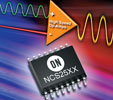Powerful and speedy op-amps for video
26 July 2006
Analogue, Mixed Signal, LSI

ON Semiconductor has expanded its high-speed op-amplifier portfolio with 500 MHz to 1,4 GHz devices for high end video applications. The seven new devices of the NCS25xx family use new technologies to achieve the ultra low distortion performance levels required for video applications. The NCS2510 and NCS2511 are current feedback devices of 1,4 GHz and 1,0 GHz respectively. The NCS2511 only consumes 7,5 mA of power versus the 12 mA of the NCS2510. The NCS2535 and NCS2540 are triple op-amps, ideal for driving component video. The NCS2535 is a 1,4 GHz current feedback device with disable; the NCS2540 is a 750 MHz voltage feedback device with disable. The NCS2550 and NCS2552 are voltage feedback devices of 750 MHz. The latter comes with an ultra fast enable feature allowing enable times in the range of 5 ns. The NCS2551 is a voltage feedback device of 500 MHz with a slew rate of 1400 V/μs. It only draws 5,5 mA. These devices will allow video designers to achieve 0,02% differential gain and 0,02 degree differential phase performance, while only consuming up to 12 mA, according to the manufacturer.
Further reading:
Online sensor technology hub
Analogue, Mixed Signal, LSI
Mouser’s sensor content hub offers an extensive collection of articles, blogs, eBooks, and product information from its technical experts and leading manufacturing partners.
Read more...
Ultra-low power MEMS accelerometer
Altron Arrow
Analogue, Mixed Signal, LSI
Analog Devices’ ADXL366 is an ultra-low power, 3-axis MEMS accelerometer that consumes only 0,96 µA at a 100 Hz output data rate and 191 nA when in motion-triggered wake-up mode.
Read more...
BT Audio 4 Click board
Dizzy Enterprises
Analogue, Mixed Signal, LSI
The BT Audio 4 Click board from MIKROE provides high-quality wireless audio streaming and data comms over Bluetooth.
Read more...
Precision MEMS IMU modules
Altron Arrow
Analogue, Mixed Signal, LSI
The ADIS16575/ADIS16576/ADIS16577 from Analog Devices are precision, MEMS IMUs that includes a triaxial gyroscope and a triaxial accelerometer.
Read more...
MEMS with embedded AI processing
Altron Arrow
Analogue, Mixed Signal, LSI
STMicroelectronics has announced an inertial measurement unit that combines sensors tuned for activity tracking and high-g impact measurement into a single, space-saving package.
Read more...
High-performance IMU
RS South Africa
Analogue, Mixed Signal, LSI
TDK Corporation has announced availability of the new InvenSense SmartMotion ICM-536xx family of high-performance 6-axis IMUs.
Read more...
High-temperature closed-loop MEMS accelerometer
RS South Africa
Analogue, Mixed Signal, LSI
This sensor from TDK is a high-temperature MEMS accelerometer with ±14 g input range and a digital interface for measurement while drilling applications.
Read more...
Dual accelerometers on the same die
Altron Arrow
Analogue, Mixed Signal, LSI
The LSM6DSV320X is the first mainstream inertial sensor to house a gyroscope alongside two accelerometers, one capable of sensing up to ±16 g and one sensing up to a staggering ±320 g.
Read more...
Dual-range IMU with edge processing
EBV Electrolink
Analogue, Mixed Signal, LSI
ST’s innovative LSM6DSV80X combines two accelerometer structures for 16 g and 80 g full-scale sensing, a gyroscope up 4000 dps, and embedded intelligence in a single component.
Read more...
High-reliability isolation amplifiers
EBV Electrolink
Analogue, Mixed Signal, LSI
The VIA series of isolation amplifiers from Vishay are designed to deliver exceptional thermal stability and precise measurement capabilities.
Read more...


